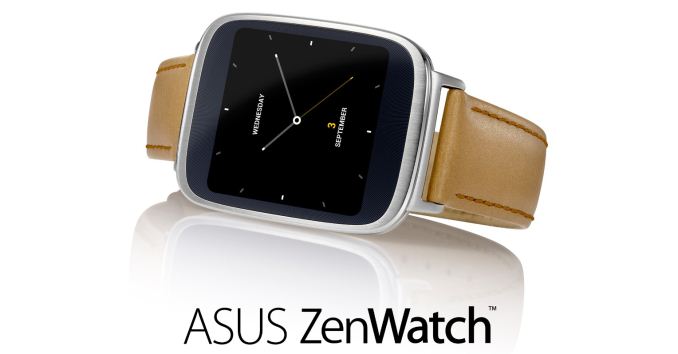ASUS Unveils the ZenWatch at IFA
by Brandon Chester on September 3, 2014 4:00 PM EST
Today ASUS threw their hat in the ring of Android Wear smartwatches with their new ASUS ZenWatch. All of the Android Wear watches sport a common hardware platform and the ZenWatch is no exception. It sports a 1.63" curved 320x320 AMOLED display, and is powered by a Qualcomm Snapdragon 400 quad Cortex-A7 part running at 1.2GHz, paired with an Adreno 305 and 512MB of RAM plus 4GB of NAND. ASUS claims that the internal 1.4Wh battery will get a user through the day, and the IP55 rating for dust and water resistance should resist environmental hazards but not to the extent of other smartwatches like the Sony SmartWatch 3.
Android Wear watches typically have to compete on price or on design and build, and it looks like the ZenWatch has chosen to go with the latter. The stainless steel design with the curved cover glass and leather strap all convey a more premium feel than other plastic smartwatches. Of course, this also means that the ZenWatch is priced as one of the more expensive smartwatch options at 199 euros. ASUS expects that the ZenWatch will be put on sale sometime during the second half of 2014.










12 Comments
View All Comments
nandnandnand - Wednesday, September 3, 2014 - link
About this and the SmartWatch 3: these are both quad core smartwatches? Wouldn't dual core be better? Even the Neptune Pine was dual core and that thing was full Android. Or do these use less power/heat?smorebuds - Wednesday, September 3, 2014 - link
If I remember correctly, Anand reviewed the LG/Samsung watches with snapdragon 400s and concluded that only 2 cores were active anyway.nandnandnand - Wednesday, September 3, 2014 - link
Thanks. I look forward to a future of holographic, 640-core, 1 PB RRAM uberwatches.55Tan - Tuesday, December 9, 2014 - link
There are a number of higher rated smartwatches, I recommend seeing http://www.topreport.org/wearable/ among others.PICman - Wednesday, September 3, 2014 - link
So, this is identical to the Sony watch: http://www.anandtech.com/show/8474/sony-announces-... ? I guess the 420 mA battery in the Sony is the same as the 1.4 Wh battery in the ASUS (1.4 Wh/ 3.7 V = 0.378 Ah)? What is the battery life in these watches? I'll guess: substantially less than 24 hours. It appears that they took an app note for a smartphone and used it for a watch.PrayForDeath - Wednesday, September 3, 2014 - link
"ASUS claims that the internal 1.4Wh battery will get a user through the day"Through the day? ONE day? I won't consider buying a smart watch until they make them last for at least a month. I'm not charging my watch every day
Brandon Chester - Wednesday, September 3, 2014 - link
Yeah for the record when I wrote that I thought to myself "I think that's about 1/7th where I would need it to be."extide - Wednesday, September 3, 2014 - link
It's obvious that we need a middle ground between the Cortex M4 and the Cortex A5/A7. I wonder if a MIPS design could perhaps slot in here? The M4 just doesn't quite have the grunt to run a full linux distro properly (I know it CAN, but you have to use uClinux, which brings a lot of issues) and then even the bottom end Cortex A series chips seem a little too heavy. Maybe someone just needs to make a 20/28nm SoC with a single-core Cortex A5 on it, run it about 800mhz-1ghz, put a very very modest GPU on there, and it really doesn't need too much else. BT, maybe wifi, some ram and storage, and you should be set. I mean it seems like all these Quad A7 designs are coming out because there just aren't any other decent SoC options out there. I hope at least someone is working on a 'baby soc' -- I mean there is obviously a market for it, and OEM's will probably buy it if it was available.tuxRoller - Wednesday, September 3, 2014 - link
I don't think the bottleneck is the CPU. The combination of screen and radio would, I imagine, be the real culprits.mkozakewich - Thursday, September 4, 2014 - link
I think the entire platform is way too powerful. Like, imagine having the power of a Nintendo DS strapped to your wrist. That thing could run a clock on two screens for just over a day. Take out one screen and the buttons, and use a modern process node, and you'd be able to shrink the battery appreciably...Anyway, look at the specs: 4 MB RAM; dual-core ARM, at 33 and 67 MHz; fairly small OS, but capable of loading media players and relatively intensive games. The only problem is that you'd have to program directly for that hardware, which is where Android Wear comes in. But they're aiming too high, and Wear would never run on that kind of hardware. Still, once we've got that kind of thing, it's just a matter of getting Bluetooth or a specialized wi-fi (think wireless mice) to work without too much power consumption.